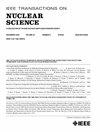The Ethernet Readout of the DUNE DAQ System
IF 1.9
3区 工程技术
Q3 ENGINEERING, ELECTRICAL & ELECTRONIC
引用次数: 0
Abstract
In 2023, the deep underground neutrino experiment (DUNE) data acquisition (DAQ) system transitioned to a new Ethernet-based readout. This required an extension to the modular readout subsystem: in particular, a new I/O device library was implemented, interfacing with the detector electronics; a firmware block was provided by the DAQ team to the electronics experts for the implementation of the data formatting and transmission; and the trigger primitive generation (TPG) software in the readout system was adapted to the modified data format. The I/O device library for controlling, configuring, and operating the network interface controllers (NICs) is built upon the data plane development kit (DPDK), supporting routing capabilities based on configurable rules. This feature allows the readout to split the data arriving on each 100-Gb/s link into individual data streams (each with a throughput of ~2 Gb/s), which are passed down to their corresponding processing pipelines for TPG and buffering. Extensive monitoring capabilities are also provided by the library, which monitors errors related to data consistency and integrity, and also aids the performance optimization work of the software stack. In this contribution, we describe the new high-throughput Ethernet-based readout integrated into the DUNE DAQ system, and the first performance results obtained at the ProtoDUNE hardware apparatus at the Neutrino Platform at CERN.求助全文
约1分钟内获得全文
求助全文
来源期刊

IEEE Transactions on Nuclear Science
工程技术-工程:电子与电气
CiteScore
3.70
自引率
27.80%
发文量
314
审稿时长
6.2 months
期刊介绍:
The IEEE Transactions on Nuclear Science is a publication of the IEEE Nuclear and Plasma Sciences Society. It is viewed as the primary source of technical information in many of the areas it covers. As judged by JCR impact factor, TNS consistently ranks in the top five journals in the category of Nuclear Science & Technology. It has one of the higher immediacy indices, indicating that the information it publishes is viewed as timely, and has a relatively long citation half-life, indicating that the published information also is viewed as valuable for a number of years.
The IEEE Transactions on Nuclear Science is published bimonthly. Its scope includes all aspects of the theory and application of nuclear science and engineering. It focuses on instrumentation for the detection and measurement of ionizing radiation; particle accelerators and their controls; nuclear medicine and its application; effects of radiation on materials, components, and systems; reactor instrumentation and controls; and measurement of radiation in space.
 求助内容:
求助内容: 应助结果提醒方式:
应助结果提醒方式:


